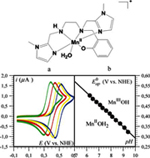Publication
676
Faraday Discuss., 148, 83 - 95, 2011
DOI: 10.1039/C004276E
|
|
|
|
|

|
Proton-coupled electron transfers in biomimetic water bound metal complexes. The electrochemical approach |
|
|
|
|
Elodie Anxolabéhère-Mallart, Cyrille Costentin, Clotilde Policar, Marc Robert, Jean-Michel Savéant and Anne-Lucie Teillout
Laboratoire d’Electrochimie Moléculaire, UMR CNRS 7591, Université Paris Diderot, 15 rue Jean-Antoine de Baïf, 75205 Paris Cedex 13, France -Laboratoire des BioMolécules, UMR 7203, UPMC, Département chimie de l’ENS, 24 rue Lhomond, 75231 Paris Cedex 05, France
Water-bound metal (M) complexes play a central role in the catalytic centers of natural systems such as Photosystem II (PSII), superoxide dismutase, cytochrome c oxidase and others. In these systems, electron transfer reactions involving the metal center are coupled to proton transfers. Besides its fundamental interest, comprehension of these reactions and of possible bio-inspired catalytic devices is an additional motivation for studying the coupling between proton and electron transfer (proton-coupled electron transfers, PCET), starting with an aqua-MII/hydroxo-MIII couple, and going to higher oxidation degrees as in the case of PSII (hydroxo-MIII/oxo-MIV couple). Factors that determine the occurrence of the stepwise and concerted pathways are recalled from the illustrating example of a recently described mononuclear osmium complex, thus opening perspectives for further studies of the biomimicking complex. PCET in a mononuclear aqua/hydroxo manganese couple was then studied using the electrochemical approach. |

